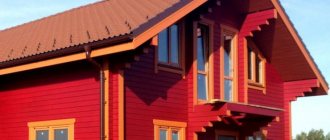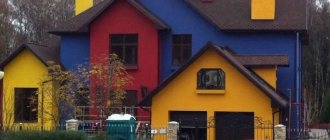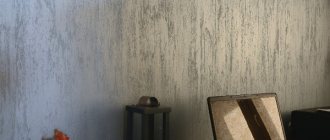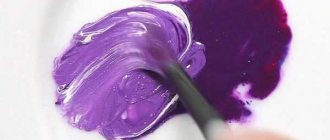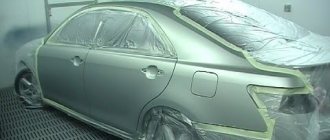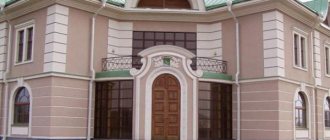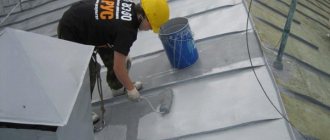When burying relatives and friends, we protect their graves with a special fence. Therefore, a metal fence cannot be assessed as a pile of unnecessary iron. It is advisable to keep it clean and tidy. And if you take into account that the fences are always in the open air. Constantly exposed to negative weather effects. Heavy rains, strong winds, snow and scorching sun only destroy metal, and therefore our love. But we don’t want to allow this to happen. In today's article you will learn how to paint a fence in a cemetery.
But how to choose paint and when to start such work. There are many similar questions, but we will look at everything in order.
What should paint resist?
Black painted fence
The fence is exposed to snow, wind and rain. In summer, the coating on it peels off due to ultraviolet rays, and in winter and autumn - due to moisture. What paint to choose for a cemetery fence?
When purchasing you need to consider:
- Water resistance.
- Application technique. The material should lie smoothly and not require special experience or special tools.
- Appearance. Naturally, paint should decorate the fence, and not spoil it.
- Wear resistance.
- Interaction with metal. If the material does not fit well, there is a risk of detachment.
- Resistant to sunlight. Ultraviolet light often causes changes in color and texture.
Preparation and painting
Considering the fact that coloring has to be done away from home, you need to have with you everything you need to complete such work. If the previous layer of paint on the fence has become unusable, it must be removed. The fence is cleaned thoroughly until the metal is shiny.
The performer of this work should have a metal brush, a spatula, coarse sandpaper and a file at hand.
You will have to work hard here, but the result will be positive. After cleaning, the surface of the material is treated with an anti-corrosion compound, and after drying, also with an antiseptic compound.
How to paint a fence in a cemetery? The more complex the design and the more intricate the patterns on it, the smaller the brush you will need for painting. The surface is covered thoroughly, without gaps. If you want to paint the fence in different colors, black is first applied, and after it dries, individual fragments are painted with a different color. When doing such work, you need to remember those to whom you pay tribute of memory and respect, mentally communicating with a loved one whose fence is being put in order.
How to paint a grave fence (2 videos)
Beautiful fences in the cemetery (27 photos)
Dark colors for fencing
The most common color for fences is black. But the primer comes in other shades:
- red;
- yellow;
- white;
- black;
- grey.
It is better to choose materials from the mid-price segment. This does not guarantee success, but it will make the choice easier.
Additional types of paint:
- Colored primer. It reliably protects the fence from corrosion and masks irregularities.
- Hammer paint. The nitro-based material is distinguished by its texture, which appears after drying.
- Enamel PF. A paint and varnish material that consists of highly dispersed pigments and varnishes. It covers the metal with a thin film, reliably preventing rust.
- Polymer coating. Contains polystyrene, solvent
When choosing a material, you need to take into account the drying time.
Alkyd and oil paints
In oil paints, the binder is drying oil made from natural oils. This type of coating can withstand heat up to 80C. At higher temperatures it is destroyed. Metal surfaces painted with oil paint quickly fade, become cracked and rust. Therefore, it should not be used when painting a metal fence.
Alkyd types of paints and enamels are well suited for galvanized metal. They have a high degree of adhesion, but cannot withstand high temperatures and quickly ignite.
Paint for a fence in a cemetery - which one to choose
Cans of paint for fencing
What is the best way to paint a metal fence in a cemetery? It is better to give preference to non-toxic enamels with anti-corrosion properties.
Universal
Universal dyes contain primer. They can also be applied to any material: wood, metal or plastic.
Universal materials are divided into two categories:
- Indoor safe, non-toxic.
- Those that cannot be used in closed spaces.
Dyes also differ in composition:
- Oily. They are not suitable for painting a cemetery fence because they do not like temperature changes and quickly lose color.
- Acrylic. Bright and durable, they can be used without worry.
- Rubber. They contain polyacrylic resins. This makes the material resistant to moisture, but unsuitable for indoor use.
- Epoxy. They protect the metal from low and high temperatures, so they are useful for hot and sunny regions.
Powder type of dye
It is a pigmented disperse system that is evenly distributed over the entire surface. Most often the substance contains:
- oligomers;
- auxiliary components;
- plasticizers;
- substances that accelerate hardening.
Unlike liquid analogues, such dyes have a number of properties:
- flowability;
- bulk density.
To apply the enamel you will need a spray gun.
Alkyd and oil paints
Alkyd enamels are superior in quality to oil enamels. They form a dense texture on the metal surface, which prevents moisture and dirt from entering. Alkyd dyes have other advantages:
- Fast drying.
- No shrinkage or cracks even after several years of use.
But there are also disadvantages:
- Possible fading after a few years. Oil-based dye needs to be reapplied regularly because it is affected by UV rays.
- If the surface is not cleaned well, the material begins to peel off after just a couple of months.
Most often, PF-133 and PF-115 enamel are used for painting metal.
Forge paint - stylish and durable
The composition contains a large number of anti-corrosion fillers - powder, fine glass. A distinctive property of forge paint is its ability to convert rust into a chemically neutral coating. As a result, the anti-corrosion properties of the paint are enhanced.
It is enough to apply blacksmith enamel to the fence once. There is no need to update it, since the service life of the coating can reach 20 years. Some compositions require preliminary priming. In this case, you need to buy a primer of the same brand as the paint.
Hammer paint - expensive and reliable
Hammer paint has the following properties:
- After application, it holds the color for a long time and does not fade.
- Repels dirt and water.
- Has anti-corrosion properties.
- Does not contain toxins dangerous to humans.
- Dries quickly after application.
- Creates a pattern on the surface that resembles shallow potholes.
Among the disadvantages of hammer enamel are the high cost and the need to remove the old coating before application.
Silicone paint
Painted fence at a cemetery
Silicone paint is not as durable as forge or hammer paint, but it is more versatile. This is a water-dispersed dye, which contains silicone resins. Water is used as a solvent.
Acrylic paints
Acrylic paints are made on a water-dispersed basis with the addition of polyacrylates. If the surface is properly prepared before applying the dye, the material will last for more than one month. However, you will still have to update it every few years.
Polymer coating
Polymer coating cannot be done independently, since painting requires a special heat chamber. Therefore, such materials are most often used in factories for building structures.
Grave fencing by type of design
According to the type of execution, all grave fences are divided into forged, welded, cast, consisting of chains on poles and mesh. In fact, the difference between them lies in the method of manufacturing the fence, the method of connecting its main elements. The more complex the manufacturing option is, the more expensive it will cost the customer. However, inexpensive grave fences are not necessarily of poor quality. Rather, they are more universal.
Forged
For forged grave fences, high-quality hardened iron is used. The components are wide, strong rods. They are usually treated with an anti-corrosion coating.
Forging is performed by professional blacksmiths; making such a product yourself will be very difficult, even with the appropriate tools.
Welded fences for the grave
Welded fences for graves are made by welding different metal parts. The process is carried out using gas or electric welding. Either metal rods or thin profile pipes are welded. The welding process is not particularly difficult.
Cast
Cast fences are also made from high-strength metal, but according to a template. In terms of production complexity, they occupy an intermediate place between forged and welded. Their strength approaches that of forged products, but this type suffers from design limitations. The manufacturing principle is associated with patterned one-piece casting.
Grave fences made of chains on poles
Grave fences made of chains on poles are made, of course, from chains. They are suspended between posts previously driven into the ground. Chains can be plastic, metal or a combination. Plastic ones are cheaper than metal ones, can withstand strong temperature changes, and will last a long time. Metal ones are more expensive, but their service life is longer. They tolerate extreme weather conditions well.
The pillars can be made of stone or concrete. They are mounted in the ground, with chains suspended between them. In this case, metal ones will look very harmonious.
Mesh
Mesh fences are made of metal mesh. First, the pillars are driven in, between which the mesh is subsequently stretched. It can serve as a support for climbing plants - hedges. The mesh can also be galvanized - more durable. However, it is worth remembering that metal fencing rods made of soft mesh can be short-lived and impractical, although they are the cheapest type of fencing.
To choose the right type of posts needed for the fence, it is best to consult with specialists in the store. In addition, they will definitely tell you about the advantages of each type.
How to prepare a fence for painting
If you do not prepare the fence for painting, the material will begin to peel off within a few months. To clean metal from rust, dirt and old coating you will need:
- water;
- brush;
- sandpaper;
- primer;
- brushes
Preparation should proceed according to the following scheme:
- Remove dirt with a brush and water.
- Remove rust with sandpaper or an electric drill with an attachment.
- Apply primer.
- Sand it.
Final stage
Don't forget to bring all the necessary painting tools from home. You will need a knife or spatula to help remove the old layer, and a brush for degreasing, priming and painting.
The metal is cleaned to a shine and polished. Sandpaper will help with this.
It would also be a good idea to take a file. Some fence designs include metal grape vines. What is the best way to paint a metal fence in a cemetery? You can paint it to match the main fence or a different color.
Detailed instructions for painting metal fencing
Hammer paint samples
Enamel helps protect the metal surface from aggressive environments, so painting is best done regularly. To work, you will need a brush, sponge or aerosol can, depending on the type of dye.
Choosing a time for painting
How to quickly paint a fence in a cemetery? Conditions are considered optimal for painting when the humidity does not exceed 80% and the temperature is from 5 to 35 degrees.
In winter, you should use closed spaces for work, and in summer, places protected from the sun and rain. In this case, the dye will last longer.
Preparing the Paint
For this it is better to use a thinner. This allows the pigment to be distributed more evenly over the surface, and the enamel dries faster.
When diluting paints and varnishes, the thinner must be added gradually, in small portions. You must strictly follow the instructions on the packaging, since excess will lead to smudges, and too little will lead to excess consumption of the substance.
Execution of work
The process of painting a fence
Once the tools are prepared and the fence is primed, you can start painting:
- It is better to install the fence first.
- Paint from top to bottom using even, wide movements with a sponge or brush.
- Wait until the first coat dries and apply another one.
- Cover the top with bitumen varnish, which will secure the result.
The process of cleaning the fence from paint
Painting a cemetery fence is an important element of grave care. If you choose paint, you can avoid the need to renew the coating for several years. Hammer and forge enamel are suitable for this purpose.
Cleaning the fence from rust, painting - varnish, enamel, paint
Fences at the cemetery are being repaired. Painting the fence on the grave.
We arrived in the spring, and the fence was peeling, there was rust in some places and it needed to be painted. Not everyone has the strength or ability to do it themselves, so we offer the service of cleaning the fence from rust, painting the fence on the grave, your choice of varnish, enamel, paint. Such services at the cemetery, if you contact the employees directly, range from 5,000 to 80,000. By contacting us, we can pay less for this service. Of course, everything will depend on the complexity of the work, where forged fences and difficult places to clean require more work and are more expensive, but there are also simple straight fences that are easy to paint and clean, cheaper. Funeral services, according to the Price List - list of prices and tariffs - are presented on the website in the section "Internet - store of funeral goods and services." The work schedule is 24/7. Ordering any type of service, consultation is carried out by phone 8(495) 943-00-90.
Cafes and restaurants for funerals 9 days, 40 days, a year.
Fence at the cemetery. Repair of the grave fence, restoration.
Technology of painting metal fences
Until recently, painting metal fences was always done in three steps. First, the surface was prepared by treating it with a rust converter, then a primer was applied, and only after that we proceeded directly to painting. Progress does not stand still and first universal primers began to appear on the market, which began to act both as a primer and as a rust converter, and then universal paints (three in one), which were applied directly to the metal.
Let's look at the process of painting a metal fence.
Preparing the Paint
Before use, the paint coating must be stirred well. To do this, you can simply shake the contents of the package, but it is better to use a special mixer or a simple stick.
To get a new color, you can mix paints. The main thing to remember is that you cannot mix different types of paints, as well as paints that have already been diluted with a solvent.
Attention! If, upon opening a can of paint, you find that the surface is covered with a film or there are clumps, then it is better to refuse to use it. Because the presence of these signs indicates that this product has expired or storage conditions have been violated, as a result of which the paint could lose its properties and all the work you have done may become in vain!
Tools needed for painting
To paint a metal fence you will need the following tools:
Detailed instructions for painting a metal fence
The video below shows the process of spray painting a metal fence:
Let's look at the properties of paints for concrete
The paint for the base must be of high quality and resistant to external factors. It must be applied over a primer, which improves the adhesion of the composition to the base. It is better to purchase primer and paints at the same time, if possible from the same manufacturer.
Acrylic paints
Paints made on the basis of acrylic resins are considered one of the most common. This is thanks to their easy application and fast drying time. These materials have virtually no odor and do not have a harmful effect on humans. With their help, it is possible to create a durable film that repels moisture from the surface. To increase the strength characteristics, you can add marble chips to the mixture. These compositions are produced mainly in white. To give the required shade you need to use a special colorant. One of the varieties of acrylic paints is acrylate. It is similar in properties, but differs in its composition. A well-known brand of such material is Tikkurila Yuki.
Silicone paints
Compositions based on silicone resins are ideal for painting plinths finished with plaster. With the help of such paint, it is possible to create a durable outer layer that can repel moisture from the outside and allow vapor to pass through from the inside. Thanks to the high degree of elasticity, no additional surface tension is created, which significantly extends the service life of the paint. In addition, it perfectly withstands the influence of ultraviolet radiation, without fading and maintaining its attractiveness.
Epoxy paint
Mixtures containing epoxy resins are considered one of the most durable. This is achieved by introducing a special hardener into the paint, which is introduced into the composition immediately before application. The cost of this type is quite high, but with the help of such material it is possible to protect the base not only from atmospheric influences, but also from mechanical damage. Polyurethane paint
Modified paint with the addition of polyurethane is durable and attractive in appearance. With its help, you can give the surface a certain texture, which increases its aesthetic qualities. But the price of such paint and varnish material is more expensive than other options. Polyurethane paint creates an excellent protective layer, protecting the surface from chemical, mechanical and atmospheric influences. The composition penetrates deeply into the base and clogs microcracks and pores. To achieve maximum strength, it is necessary to apply the paint in two layers. The second one needs to cover the surface after the first one has dried. Within a week the base will gain mechanical strength, and after two weeks it will become resistant to aggressive influences. Silicate
To paint surfaces made of mineral materials, compositions based on liquid glass are used. Of all the paints, silicate is the most commonly used for painting bases. This is due to its excellent quality characteristics: resistance to mechanical and chemical stress, the influence of precipitation - combined with an affordable price. However, there are also disadvantages to silicate paints. Among the main ones are a long drying period and a low coefficient of vapor permeability. Alkyd
Unlike silicate paints, alkyd compounds are used for painting wooden and metal surfaces. They have good protective properties, minimize the influence of moisture and aggressive substances, which makes it possible to clean the base using chemical compounds. Despite the high resistance to ultraviolet radiation, it is necessary to periodically update the surface. This should be done approximately once every three years. Oily
Like all other types of paint , compositions based on drying oil are strong and durable. The material dries within 24 hours, creating a protective film on the surface. This paint has a very attractive appearance and is consumed very economically, while the cost of such a paint coating is quite acceptable, which makes it not only reliable, but also profitable. Cement
This type of paint is made from cement with the addition of coloring pigments, as well as lime. They are not suitable for painting wood and metal. But for concrete, brick and plastered surfaces, this is a very profitable option, since the composition allows you to create a durable protective coating that not only prevents the penetration of moisture, but also perfectly complements the exterior due to its aesthetic appearance. Any of the listed paint and varnish materials can make the base attractive , while providing additional protection from the influence of external factors. But this is only possible if the application technology is followed.
If you paint the cemetery fence with high-quality paints and varnishes, it will look attractive on the grave of a person close to your heart, being a silent evidence of the attention and care of the one who cares for the grave.
